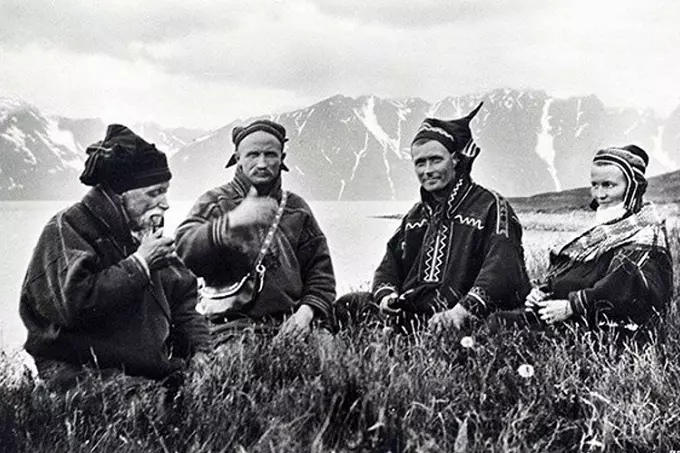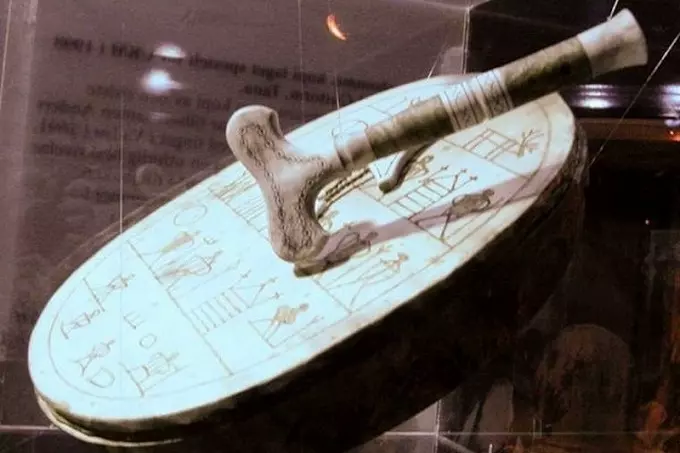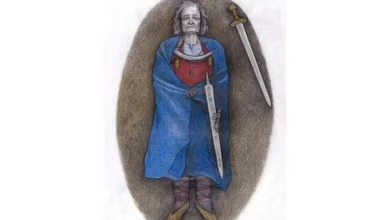Noaidi – the amazing wizards of Lapland

Back in the Middle Ages, the fame of the most powerful magicians in the world was established behind the Lapland shamans. Even the Finns, who were also known as brilliant magicians, bowed before their knowledge and strength.
Noaidi (noid, kebun) is the name of a shaman among the Sami people (Lapps), common in the territories of Norway, Sweden, Finland and northern Russia. According to one version of Sami beliefs, Noaidi are considered “good” shamans who help people, in contrast to “bad” geydu (witches) who can harm people.
Since ancient times, Lapland shamans have been credited with incredible abilities – as if they not only see the future and know the past, heal from any ailments, but even know how to fly, control the winds, reincarnate, and at the right time it doesn’t cost them anything and completely disappear.
True, they say that now there is no trace of the former skill: the last shaman was allegedly shot back in the 30s of the last century. Although, who knows, perhaps even today real keepers of ancient mysteries and magical secrets live in Lapland. After all, it is not for nothing that the northern region is full of rumors that strange people are hiding in the mountains, hiding from human eyes in mysterious underground caves and unknown stone labyrinths.
A large witch’s tambourine, covered with deerskin and decorated with magical symbols, responds with a dull sound to the rhythmic beats of its owner. Whirling in an outlandish dance, the shaman begins to hum strange, unusual melodies for our ears. This is how the Noaidi, the shamans of Lapland, began their magical work in ancient times.
Lapland is the northernmost territories of Finland, Sweden and Norway, located mainly above the Arctic Circle. This is an amazing magical corner of our planet, the silver edge of eternal winter, the kingdom of cold and snow, the harsh land of sorcerers and witches, the land of the Sami – the indigenous people of Finland.
The Saami, those that in Russia have long been called Lapps or Laplanders, are one of the most ancient peoples of Europe, descendants of mammoth hunters. The first Saami settlements appeared in the north of the country about five thousand years ago. The old-timers of Lapland managed to tame restive deer and learn the secrets of the harsh northern nature.

And although now the masters of the north live in their tents only in summer (and those tents are not made of skins, but canvas ones), they still try to maintain ancient traditions: they are engaged in reindeer herding, perform rituals on Lake Inari, where their pagan gods live and, of course, a little “shaman”.
The witchcraft rite of the Noaidi shaman came to us from time immemorial. With the help of spells and a wizard-tambourine, the shaman brought people present at the magical action into a state close to hypnotic sleep.
Then he took out a deer bone and threw it on the plane of the tambourine. The sign on which the bone fell, and told about what awaits a person in the future.
Once upon a time, the great fame of the Sami shamans thundered throughout Europe, and in 1584 Tsar Ivan the Terrible himself ordered as many as 60 sorcerers from Lapland to explain a strange phenomenon – a comet that appeared in the sky – which the tsar for some reason perceived as a sign of his death.
It should be noted that Lapland, at that time, when Russia and Europe did not yet know Siberia, was considered the place where the most powerful wizards of the Old World live, and many occultists went there for training.
It is not known with the help of what actions, but absolutely unanimously, the Lappish sorcerers came to the conclusion that the sovereign would indeed leave this world very soon, and this would happen on March 18. Ivan the Terrible, not believing that May had left him to live like this, became furious and ordered all the sorcerers to be burned on March 18 for such a blatant lie.
On the morning of the indicated date, the Laplanders were ordered to prepare for the execution, but the shamans answered philosophically that “it is not yet evening.” And they were right: in the evening of the same day, Ivan the Terrible suddenly fainted and died by nightfall. And after the death of Ivan the Terrible, loud talk about the Lappish wizards resumed in the Russian capital with renewed vigor.
They stirred up the people, especially after the coup of 1606, when the impostor Grigory Otrepyev was killed. His body, with many wounds, lay on Red Square for several days, put on public display. But supporters of the Troubles immediately started a rumor that “Grishka was a sorcerer who learned witchcraft from the Lapps: when they let themselves be killed, they can resurrect themselves,” that is, they say, not everything is still lost.
Moreover, there may have been some realities behind the rumors.
In any case, a serious historian N. M. Karamzin cites in his “History of the Russian State” the following passage from the “Moscow Chronicle”: appeared as soon as they departed. When his body was taken to a squalid house, a terrible storm broke out, tore off the roof of the tower on Kulishka and toppled the wooden wall at the Kaluga Gate. In a wretched house, this body was moved from place to place by an invisible force, and a dove was seen sitting on it. There was great anxiety. Some considered False Dmitry an extraordinary person, others – a devil, at least a sorcerer, taught this infernal art by Lapland wizards who ordered to kill themselves and then revive them.
Such facts, rumors or conjectures, whatever they were, in any case played their role – after a while, the people accepted the news with relative ease that a second False Dmitry had appeared in Poland. So the shamans of Lapland, for the first time “in a big way,” influenced politics.
The supernatural abilities of the Sami shamans have been believed since ancient times. People had no doubt that the Lapland sorcerers had power over the winds. During the Middle Ages, it was generally accepted that the spirits of Lapland were very powerful and can raise the wind or bring down a hurricane according to the conventional sign of the Noaidi when it untied the magic knots.
As they wrote at the time, “Noaidi, untying three magic knots one after the other, caused the appearance of first a moderate wind, then a strong one, and finally a hurricane with thunder and lightning from one side of the sky to the other.” Adam of Bremen, an 11th-century chronicler, mentioned that Lapland shamans could find out what people were doing in remote places and cast whales ashore with the power of spells. The mystical glory of the shamans was transferred to the entire Sami people.
The Swedes put an end to witchcraft and paganism of the indigenous people of Finland, at the end of the 17th century destroyed the religious buildings of the Sami. Shamanism was banned, and anyone who dared to take up a witch’s tambourine was severely punished. The traditional Sami songs “eyku”, which shamans sang during the kamlanie (magic ceremony), were also banned.
Shaman tambourines – an auxiliary means of a shaman – were ordered to burn every single one. In documents of the 17th century that have survived to this day, describes the trials of shamans who practiced “harmful” magic. From 1593 to 1695, 175 people were convicted “for witchcraft” in northern Norway alone.
But a small people lost in the tundra managed to preserve their ancient traditions. The Sami have preserved to this day the technology of making tambourines from deerskin. Perhaps the tambourine is the only musical instrument in the world that is tuned by heating over a fire. Shamans have a special, reverent attitude towards him.
“The tambourine, like all things, is alive. Hear how he sings! I touch it a little, and it already sounds, – says a modern shaman, Estonian Tiit Teras, a happy owner of a real tambourine from Lapland. – But only when I care about him, when I communicate with him. My old tambourine was offended when I got a new one.
Since then, the old tambourine no longer sounds so beautiful when I beat it. But I gave it to a friend, and the voice came back. You need to be able to beat the tambourine. I have two sticks for this. The frequency of beats is important: 4-7 beats per second.
In other words, it helps to stop the activity of the left hemisphere of the brain and activate the work of the right hemisphere, to go into a state of altered consciousness. It is no coincidence that the tambourine is round. This circle includes east, south, west and north, it is a model, a symbol of the world.
In addition to tambourines, the Sami shamans also had other powerful devices – “chuerv-garts”. These “devices” were made of deer antlers and stones. By moving the horns, the shaman could control the weather, hunting and fishing. One of these structures is located on Mount Ninchurt – several old half-decayed horns are neatly laid out on a large stone.
But the most powerful patrons of the Sami are the cult places of their ancestors – seida (“sacred place”). Seid can be a stone, a hill, a reservoir, and a tree – everything where the power of nature is concentrated. The Saami considered nature to be alive, it had to be reckoned with. Seyds have long been worshiped, they were looking for protection. It was believed that through ritual rites of respectful behavior it was possible to strengthen the spiritual connection between man and natural forces.
Even now in Lapland, seids are treated with awe and reverence, but in the old days, faith in their power was absolute. People believed that the souls of ancestors and spirits lived in the seids, even that the seids were these spirits themselves. Sometimes it was believed that some seids were bewitched people.
The connection of the seid cult with Lapland magic was so great that the legends described cases when a noida shaman, dying, “turned” into a seid, helping his fellow tribesmen from the other world. For example, a legend has been preserved about how a Noida named Syrets after his death became a seid of Rept-Kedgi. This seid could control the weather, both by fulfilling requests for good weather and by sending a storm on those who went to the mountains to destroy him.
According to some legends, seids, as embodied shamans-noidas, connected the world of the living with the world of the departed. There was a belief that seid lives as long as people revere him, otherwise he loses his magical properties.
Thus, from the point of view of the Sami, the seids were inhabited by spirits capable of helping a person both in magic and in everyday life in exchange for offerings. An old legend says that the sacred stone is beautiful and shiny when it is all smeared with deer fat. The destruction of sacred stones was severely punished, for it was believed that this would bring terrible disasters.
Nikolai Volkov, a Russian researcher of Sami shamanism, wrote in great detail about the cult of seids:
“Seid was usually an object of veneration for the entire village and, apparently, was associated with the veneration of the ancestors. Initially, seids were undoubtedly tribal fetishes. As the family lands were fragmented, seids turned into family fetishes.
Seid, unlike material objects of magic, is an object of worship and reverence. First of all, a person considers the interests of the seida. Seid not only demands respect for himself, but also the observance of certain rules in the area of his influence, especially nearby, in plain sight.
Silence, unconditional refraining from swearing and even joking are ubiquitous rules. Seid also loves gifts and food, which is loved by the Saami. In return for the attention given, he drives fish into the net, helps in hunting and grazing deer. For inattention, ridicule and rudeness, the seid severely punishes the guilty not only with deprivation of trades, but also with diseases and even death … ”
Amazing phenomena are associated with the Sami seids, of which there are a great many in Lapland. It is impossible not to pay attention to some anomalous phenomena that are observed in places where the seid complexes are located.
These are subjective sensations of some mental impact (both positive and negative), and strange problems that arise with photo and video equipment during the shooting of seids. So, it often happens that when shooting this or that seid on an ultra-modern digital camera, a strange effect is observed – in the picture the surrounding landscape is clearly visible, and the contours of the seid are slightly blurred.
The seid plateau on the Vottovaara mountain is well known for such tricks. One of the seids of this plateau is also the source of a magnetic anomaly – the compass needle around the seid literally moves in a circle. Whether the stone itself is the cause of the magnetic anomaly or simply placed above it remains unclear, but the fact itself suggests the extensive knowledge of the ancient shamans, including the magnetic properties of the Earth.
It is possible that the famous Lapland magic is nothing more than scraps of absolutely scientific knowledge of a forgotten prehistoric people. It is likely that only a special caste of Sami shamans managed to adopt and adapt this knowledge, while the rest of the inhabitants of Lapland were left with only a primitive reverence and a set of prohibitions associated with stones.
The mythological and “materialistic” phenomena associated with seids are extremely multifaceted. Although the ancient Sami explained everything by the fact that a “spirit” lives in a stone, modern researchers of the seid phenomena have yet to unravel the mysteries of the “Arctic megaliths” of Lapland.
True, the fantastic northern country is in no hurry to reveal its secrets. Today in Lapland, where the population density is 1 person and 2 deer per square kilometer, there is everything: cities, resorts, water parks. And all this the land of the Sami hospitably offers to tourists visiting it.
But the masters of the north prefer not to talk about sorcerers, shamans and mysterious seids with strangers, although other traditions that they have inherited from their ancient ancestors demonstrated with pleasure. Well, perhaps with time, everything will change, and we will learn the secrets of Lapland seids.




